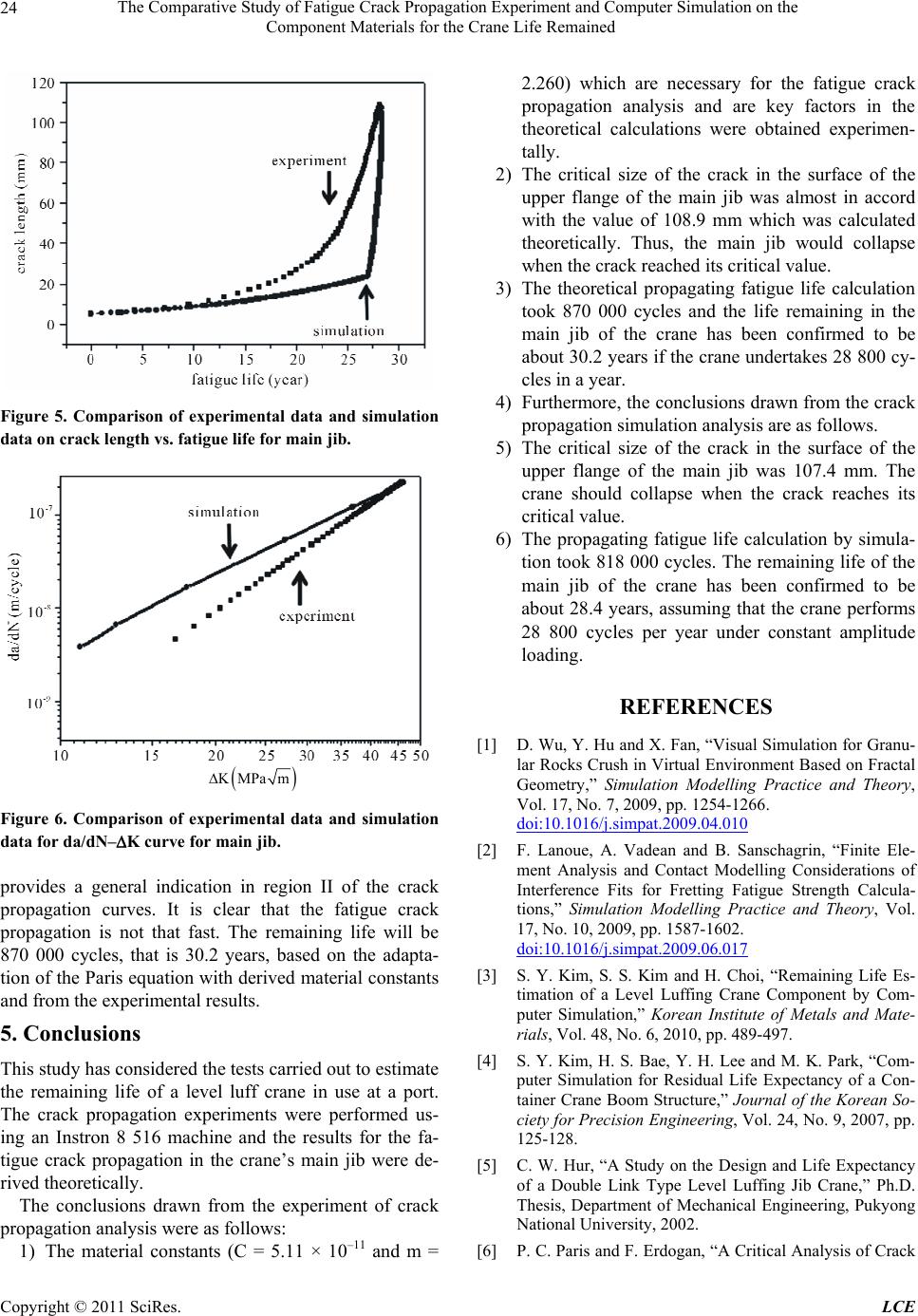
The Comparative Study of Fatigue Crack Propagation Experiment and Computer Simulation on the
24
Component Materials for the Crane Life Remained
Figure 5. Comparison of experimental data and simulation
data on crack length vs. fatigue life for main jib.
KMPa m
Figure 6. Comparison of experimental data and simulation
data for da/dN–K curve for main jib.
provides a general indication in region II of the crack
propagation curves. It is clear that the fatigue crack
propagation is not that fast. The remaining life will be
870 000 cycles, that is 30.2 years, based on the adapta-
tion of the Paris equation with derived material constants
and from the experimental results.
5. Conclusions
This study has considered the tests carried out to estimate
the remaining life of a level luff crane in use at a port.
The crack propagation experiments were performed us-
ing an Instron 8 516 machine and the results for the fa-
tigue crack propagation in the crane’s main jib were de-
rived theoretically.
The conclusions drawn from the experiment of crack
propagation analysis were as follows:
1) The material constants (C = 5.11 × 10–11 and m =
2.260) which are necessary for the fatigue crack
propagation analysis and are key factors in the
theoretical calculations were obtained experimen-
tally.
2) The critical size of the crack in the surface of the
upper flange of the main jib was almost in accord
with the value of 108.9 mm which was calculated
theoretically. Thus, the main jib would collapse
when the crack reached its critical value.
3) The theoretical propagating fatigue life calculation
took 870 000 cycles and the life remaining in the
main jib of the crane has been confirmed to be
about 30.2 years if the crane undertakes 28 800 cy-
cles in a year.
4) Furthermore, the conclusions drawn from the crack
propagation simulation analysis are as follows.
5) The critical size of the crack in the surface of the
upper flange of the main jib was 107.4 mm. The
crane should collapse when the crack reaches its
critical value.
6) The propagating fatigue life calculation by simula-
tion took 818 000 cycles. The remaining life of the
main jib of the crane has been confirmed to be
about 28.4 years, assuming that the crane performs
28 800 cycles per year under constant amplitude
loading.
REFERENCES
[1] D. Wu, Y. Hu and X. Fan, “Visual Simulation for Granu-
lar Rocks Crush in Virtual Environment Based on Fractal
Geometry,” Simulation Modelling Practice and Theory,
Vol. 17, No. 7, 2009, pp. 1254-1266.
doi:10.1016/j.simpat.2009.04.010
[2] F. Lanoue, A. Vadean and B. Sanschagrin, “Finite Ele-
ment Analysis and Contact Modelling Considerations of
Interference Fits for Fretting Fatigue Strength Calcula-
tions,” Simulation Modelling Practice and Theory, Vol.
17, No. 10, 2009, pp. 1587-1602.
doi:10.1016/j.simpat.2009.06.017
[3] S. Y. Kim, S. S. Kim and H. Choi, “Remaining Life Es-
timation of a Level Luffing Crane Component by Com-
puter Simulation,” Korean Institute of Metals and Mate-
rials, Vol. 48, No. 6, 2010, pp. 489-497.
[4] S. Y. Kim, H. S. Bae, Y. H. Lee and M. K. Park, “Com-
puter Simulation for Residual Life Expectancy of a Con-
tainer Crane Boom Structure,” Journal of the Korean So-
ciety for Precision Engineering, Vol. 24, No. 9, 2007, pp.
125-128.
[5] C. W. Hur, “A Study on the Design and Life Expectancy
of a Double Link Type Level Luffing Jib Crane,” Ph.D.
Thesis, Department of Mechanical Engineering, Pukyong
National University, 2002.
[6] P. C. Paris and F. Erdogan, “A Critical Analysis of Crack
Copyright © 2011 SciRes. LCE